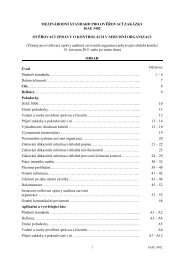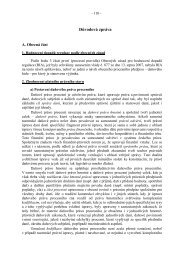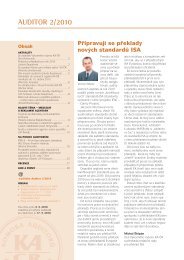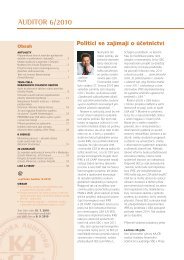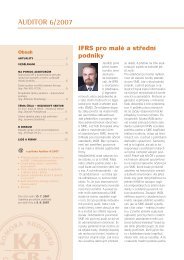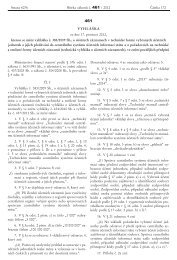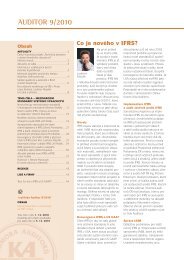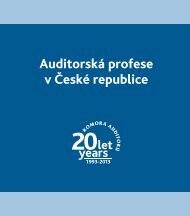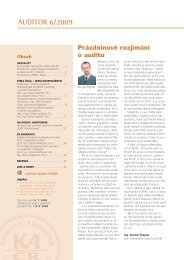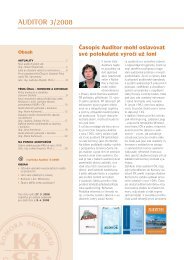Guide to Using International Standards on Auditing in - IFAC
Guide to Using International Standards on Auditing in - IFAC
Guide to Using International Standards on Auditing in - IFAC
You also want an ePaper? Increase the reach of your titles
YUMPU automatically turns print PDFs into web optimized ePapers that Google loves.
138<br />
<str<strong>on</strong>g>Guide</str<strong>on</strong>g> <str<strong>on</strong>g>to</str<strong>on</strong>g> <str<strong>on</strong>g>Us<strong>in</strong>g</str<strong>on</strong>g> <str<strong>on</strong>g>Internati<strong>on</strong>al</str<strong>on</strong>g> <str<strong>on</strong>g>Standards</str<strong>on</strong>g> <strong>on</strong> <strong>Audit<strong>in</strong>g</strong> <strong>in</strong> the Audits of Small- and Medium-Sized Entities Volume 1—Core C<strong>on</strong>cepts<br />
Exhibit 11.1-1<br />
Level of Estimati<strong>on</strong> Uncerta<strong>in</strong>ty Involved<br />
Low Level of Uncerta<strong>in</strong>ty (Less RMM)<br />
Bus<strong>in</strong>ess activities that are not complex.<br />
Relate <str<strong>on</strong>g>to</str<strong>on</strong>g> rout<strong>in</strong>e transacti<strong>on</strong>s.<br />
Derived from data (referred <str<strong>on</strong>g>to</str<strong>on</strong>g> as “observable” <strong>in</strong> the c<strong>on</strong>text<br />
of fair value account<strong>in</strong>g) that is readily available, such as<br />
published <strong>in</strong>terest-rate data or exchange-traded prices of<br />
securities.<br />
Method of measurement prescribed by the applicable<br />
f<strong>in</strong>ancial report<strong>in</strong>g framework is simple and applied easily.<br />
Fair value account<strong>in</strong>g estimates, where the model used <str<strong>on</strong>g>to</str<strong>on</strong>g><br />
measure the account<strong>in</strong>g estimate is well known or generally<br />
accepted, provided that the assumpti<strong>on</strong>s or <strong>in</strong>puts <str<strong>on</strong>g>to</str<strong>on</strong>g> the<br />
model are observable.<br />
High Level of Uncerta<strong>in</strong>ty (Higher RMM)<br />
Highly dependent up<strong>on</strong> judgment, such as the<br />
outcome of litigati<strong>on</strong> or the amount and tim<strong>in</strong>g of<br />
future cash flows, dependent <strong>on</strong> uncerta<strong>in</strong> events<br />
many years <strong>in</strong> the future.<br />
NOT calculated us<strong>in</strong>g recognized measurement<br />
techniques.<br />
Results of the audi<str<strong>on</strong>g>to</str<strong>on</strong>g>r’s review of similar account<strong>in</strong>g<br />
estimates made <strong>in</strong> the prior period f<strong>in</strong>ancial<br />
statements <strong>in</strong>dicate a substantial difference<br />
between the orig<strong>in</strong>al account<strong>in</strong>g estimate and the<br />
actual outcome.<br />
Fair value account<strong>in</strong>g estimates for derivative<br />
f<strong>in</strong>ancial <strong>in</strong>struments are not publicly traded.<br />
Fair value account<strong>in</strong>g estimates for which a highly<br />
specialized entity-developed model is used, or for<br />
which there are assumpti<strong>on</strong>s or <strong>in</strong>puts that cannot<br />
be observed <strong>in</strong> the marketplace<br />
Note: The audi<str<strong>on</strong>g>to</str<strong>on</strong>g>r (us<strong>in</strong>g professi<strong>on</strong>al judgment) is required <str<strong>on</strong>g>to</str<strong>on</strong>g> determ<strong>in</strong>e whether any of the identified<br />
account<strong>in</strong>g estimates (those hav<strong>in</strong>g a high estimati<strong>on</strong> uncerta<strong>in</strong>ty) give rise <str<strong>on</strong>g>to</str<strong>on</strong>g> significant risks. If a<br />
significant risk is identified, the audi<str<strong>on</strong>g>to</str<strong>on</strong>g>r is also required <str<strong>on</strong>g>to</str<strong>on</strong>g> obta<strong>in</strong> an understand<strong>in</strong>g of the entity’s<br />
c<strong>on</strong>trols, <strong>in</strong>clud<strong>in</strong>g c<strong>on</strong>trol activities.<br />
When the audit evidence had been obta<strong>in</strong>ed, the reas<strong>on</strong>ableness of the estimates would be evaluated and<br />
the extent of any misstatement identified:<br />
• Where the evidence supports a po<strong>in</strong>t estimate, the difference between the audi<str<strong>on</strong>g>to</str<strong>on</strong>g>r’s po<strong>in</strong>t estimate and<br />
management’s po<strong>in</strong>t estimate c<strong>on</strong>stitutes a misstatement.<br />
• Where the audi<str<strong>on</strong>g>to</str<strong>on</strong>g>r has c<strong>on</strong>cluded that us<strong>in</strong>g the audi<str<strong>on</strong>g>to</str<strong>on</strong>g>r’s range of reas<strong>on</strong>ableness provides sufficient<br />
appropriate audit evidence, a management po<strong>in</strong>t estimate that lies outside the audi<str<strong>on</strong>g>to</str<strong>on</strong>g>r’s range would<br />
not be supported by audit evidence. In such cases, the misstatement is no less than the difference<br />
between management’s po<strong>in</strong>t estimate and the nearest po<strong>in</strong>t of the audi<str<strong>on</strong>g>to</str<strong>on</strong>g>r’s range.<br />
A difference between the outcome of an account<strong>in</strong>g estimate and the amount orig<strong>in</strong>ally recognized or disclosed<br />
<strong>in</strong> the f<strong>in</strong>ancial statements does not necessarily represent a misstatement of the f<strong>in</strong>ancial statements. This is<br />
particularly the case for fair value account<strong>in</strong>g estimates, as any observed outcome is <strong>in</strong>variably affected by<br />
events or c<strong>on</strong>diti<strong>on</strong>s subsequent <str<strong>on</strong>g>to</str<strong>on</strong>g> the date at which the measurement is estimated for purposes of the f<strong>in</strong>ancial<br />
statements.




